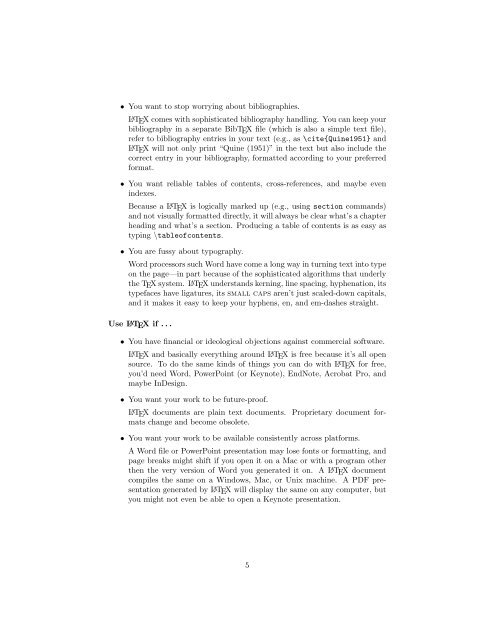LATEX for Philosophers - University of Calgary
LATEX for Philosophers - University of Calgary
LATEX for Philosophers - University of Calgary
Create successful ePaper yourself
Turn your PDF publications into a flip-book with our unique Google optimized e-Paper software.
• You want to stop worrying about bibliographies.<br />
L A TEX comes with sophisticated bibliography handling. You can keep your<br />
bibliography in a separate BibTEX file (which is also a simple text file),<br />
refer to bibliography entries in your text (e.g., as \cite{Quine1951} and<br />
L A TEX will not only print “Quine (1951)” in the text but also include the<br />
correct entry in your bibliography, <strong>for</strong>matted according to your preferred<br />
<strong>for</strong>mat.<br />
• You want reliable tables <strong>of</strong> contents, cross-references, and maybe even<br />
indexes.<br />
Because a L A TEX is logically marked up (e.g., using section commands)<br />
and not visually <strong>for</strong>matted directly, it will always be clear what’s a chapter<br />
heading and what’s a section. Producing a table <strong>of</strong> contents is as easy as<br />
typing \table<strong>of</strong>contents.<br />
• You are fussy about typography.<br />
Word processors such Word have come a long way in turning text into type<br />
on the page—in part because <strong>of</strong> the sophisticated algorithms that underly<br />
the TEX system. L A TEX understands kerning, line spacing, hyphenation, its<br />
typefaces have ligatures, its small caps aren’t just scaled-down capitals,<br />
and it makes it easy to keep your hyphens, en, and em-dashes straight.<br />
Use L A TEX if . . .<br />
• You have financial or ideological objections against commercial s<strong>of</strong>tware.<br />
L A TEX and basically everything around L A TEX is free because it’s all open<br />
source. To do the same kinds <strong>of</strong> things you can do with L A TEX <strong>for</strong> free,<br />
you’d need Word, PowerPoint (or Keynote), EndNote, Acrobat Pro, and<br />
maybe InDesign.<br />
• You want your work to be future-pro<strong>of</strong>.<br />
L A TEX documents are plain text documents. Proprietary document <strong>for</strong>mats<br />
change and become obsolete.<br />
• You want your work to be available consistently across plat<strong>for</strong>ms.<br />
A Word file or PowerPoint presentation may lose fonts or <strong>for</strong>matting, and<br />
page breaks might shift if you open it on a Mac or with a program other<br />
then the very version <strong>of</strong> Word you generated it on. A L A TEX document<br />
compiles the same on a Windows, Mac, or Unix machine. A PDF presentation<br />
generated by L A TEX will display the same on any computer, but<br />
you might not even be able to open a Keynote presentation.<br />
5
















